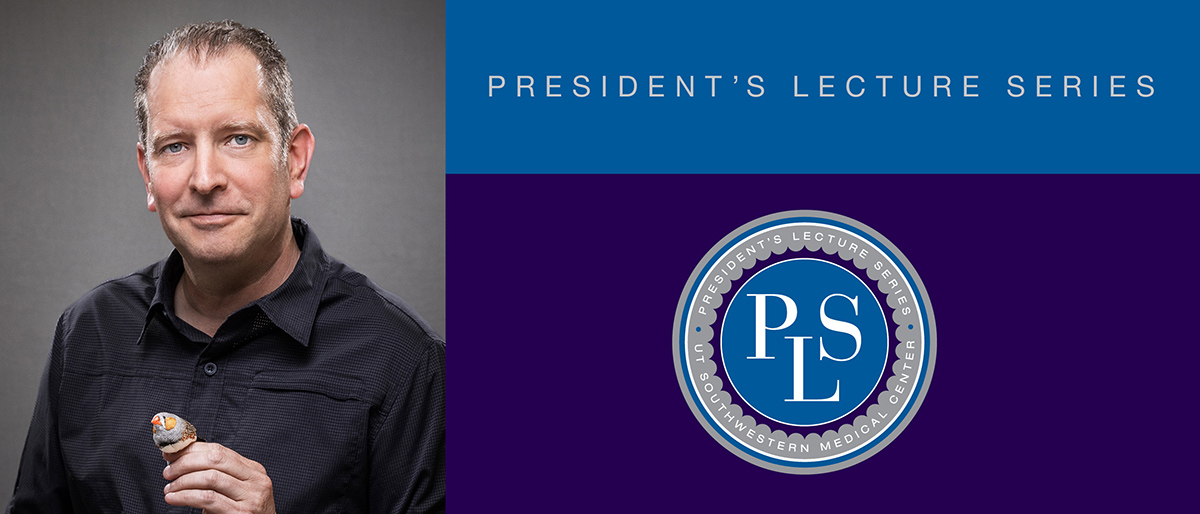President’s Lecture Series: Songbirds’ sweet sounds reveal how vocal communication begins

About half of the estimated 10,000 known bird species learn their vocalizations through imitation – a type of learning that shares many behavioral and genetic features with how humans learn to talk. Unlike other common lab models, such as mice, rats, and flies, studying these birds can shed light on the process behind how language acquisition takes place, as well as conditions in which it sometimes goes awry, such as with autism spectrum disorder (ASD).
Todd Roberts, Ph.D., Associate Professor of Neuroscience and an Investigator in the Peter O’Donnell Jr. Brain Institute, has made vocal learning in birds the focus of his career. His work centers on zebra finches, a songbird species commonly kept as pets in the U.S.
Dr. Roberts will detail his research on Sept. 19 as the next speaker in the 2024 President’s Lecture Series. The 4 p.m. lecture, titled “What’s in a song? How songbirds teach us about learning and vocal communication,” will take place in the Tom and Lula Gooch Auditorium.
Dr. Roberts’ initial interest in this topic was sparked by his own childhood experiences. His family moved from Houston, Texas, to Brazil when he was about 6 months old to support his scientist father’s research on malaria and other mosquito-borne diseases. There, he simultaneously learned Brazilian Portuguese and English, becoming the most fluent bilingual speaker in his household.

But soon after Dr. Roberts moved back to the U.S. at age 7, he stopped speaking Portuguese and lost the ability to speak or understand the language. As an undergraduate neuroscience major at the University of Maryland, he was fascinated by how vocal learning was gained and lost. To explore that question, he joined a lab investigating vocal learning in parrots and stayed there to pursue his Ph.D., examining neural pathways necessary for parrots to imitate vocalizations and mapping them out in the avian brain.
In postdoctoral training at Duke University, he investigated vocal learning in the most studied songbirds – zebra finches – which are easier to genetically manipulate than parrots, allowing for a wider range of experiments, Dr. Roberts explained. He explored how and where in the brain male zebra finches form vocal memories of the songs their fathers sang – tunes that have been passed down from generation to generation for time immemorial that are pivotal to attracting females. He and his colleagues discovered that these vocal memories are stored in the brain’s premotor circuits rather than in the auditory forebrain, upending long-held views in the field.
When Dr. Roberts joined the UTSW faculty in 2013, he expanded his research in new directions, looking into how zebra finches refine their initial “noisy” efforts into tunes that faithfully reproduce their fathers’ songs. In a paper published in 2018 in Neuron, Dr. Roberts and his colleagues showed that neurons releasing dopamine – a brain chemical associated with reward and pleasure – can be manipulated to teach birds to sing their songs in new ways. In 2019 in Science, he and his team confirmed that zebra finch vocal memories can be purposely altered using a technique known as optogenetics, causing the birds to sing significantly different songs by strengthening the activity of some neurons while dampening the activity of others.
More recently, the Roberts Lab has focused on which qualities of a bird’s songs are attractive to females, publishing a paper just this past March in Nature that used artificial intelligence techniques to assess zebra finches’ complicated melodies. Ongoing research with collaborator Genevieve Konopka, Ph.D., Professor of Neuroscience, aims to decipher the evolutionary roots of neural circuits involved in social behaviors necessary for vocal learning, some of which overlap with neural circuits implicated in ASD. In new research, Dr. Roberts and his lab colleagues are trying to understand the neural underpinnings of male birds’ ability to sing and motivations to teach songs to their sons.
“Complex vocal learning is not ubiquitous among animals – it seems to be extraordinarily special, shared by songbirds, humans, and just a few other species,” he said. “By studying this special form of learning in birds, we are unlocking new knowledge of what makes us human.”
Dr. Konopka holds the Townsend Distinguished Chair in Research on Autism Spectrum Disorders and is a Jon Heighten Scholar in Autism Research.
Dr. Roberts is a Thomas O. Hicks Scholar in Medical Research.

